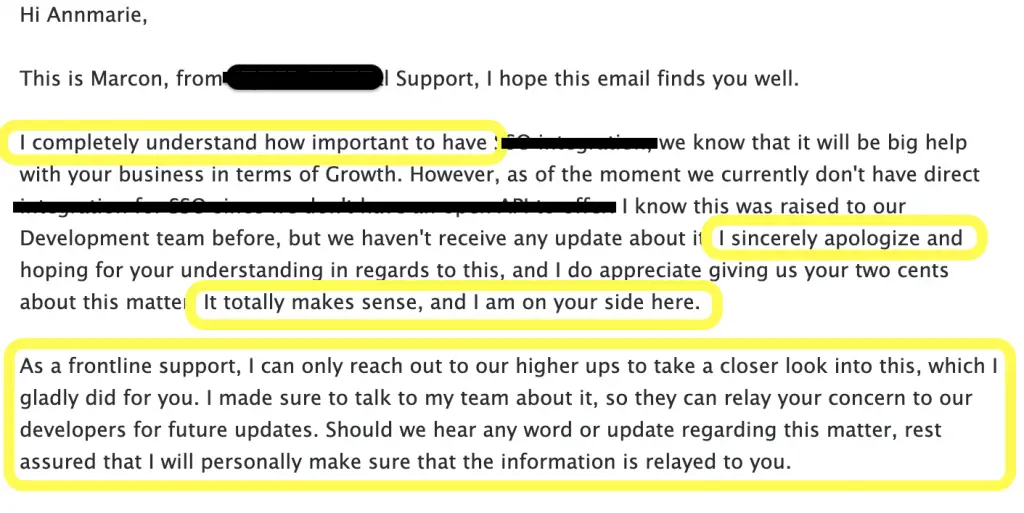#233: Empathy in English | For Client Care and Personal Relationships

How can you express the feeling of sincere empathy in English, whether you’re working with an upset customer or talking with a close friend who just lost her job?
Today I’m sharing with you 4 immediately effective strategies and more than 25 common phrases you can use to genuinely demonstrate empathy in English.
Here’s why:
A few weeks ago, a member of my Confident Women Community shared that she had started a new job as a customer service representative in an American company.
Within the first couple of weeks, she found that her language for expressing empathy was limited” and she asked if I would share some new ways “to express the feelings of sincere empathy.”
100% yes.
Empathy is an integral part of emotional intelligence and is a highly sought-after skill in client relations. Moreover, it’s essential for positive communication with team members and strong personal relationships with loved ones.
So whether you’re looking to sharpen your professional & English-speaking skills in customer service or you want to ensure effective communication with everyone around, here are 4 strategies you can immediately implement along with essential phrases you can use.
Plus, I’ll share a recent customer service email I received as a frustrated client. It was one of the best I’ve ever received and a fantastic example of high-quality customer service.
Express Empathy in English — 4 Strategies for Client Relations and Personal Relationships
To get started, let’s do a quick review of what empathy means because I often hear mistakes with empathy vs. sympathy in English.
What is empathy?
- Empathy means experiencing and feeling with others. This means that you choose to take on their feelings and understand their perspective — without always rushing to find the positive of a negative situation or immediately solving the issue.
- Words that we often associate with empathy are “I understand.”
How is it different from sympathy?
- Sympathy, on the other hand, focuses on showing concern, pity, or sorrow towards the individual’s situation.
- The focus is on how you feel about the situation and you’ll typically hear the words “I’m sorry” in expressing sympathy.
It’s easy to confuse one for the other, so let’s take a look at both responses in an example.
Imagine a friend told you that she recently lost her job.
A sympathetic response would be:
- “I’m sorry to hear that you lost the job. That place wasn’t worth your time anyway. On the bright side, you received a decent severance package.”
An empathetic response would be:
- “I understand how much you loved and relied on this job. I’m here for you, so please let me know if there’s anything I can do to help you get through this time.”
Notice how one sounds more understanding and deeply connected to the person than the other?
In the sympathetic response, you’re approaching the person with the intention to express how sorry you are that they are in such a predicament.
However, in the emphatic response, you establish a deeper connection and demonstrate emotional intelligence by saying that you understand the person’s emotions, troubles, and situation.
The ability to empathize demonstrates that you understand how someone else is feeling, leading to compassionate responses and, ultimately, a deeper connection as well as a strong level of trust.
Strategy #1: Acknowledge Their Feelings/Concerns
By acknowledging someone’s concern, frustration, disappointment, anger or positive emotions such as excitement, you immediately establish a connection to the individual. Rather than a me vs. you situation, it becomes an us situation.
There is a feeling that we’re in it together and ready to find a solution.
An important part of this step is to identify the emotion, whether negative or positive.
Here are two scenarios that highlight how you might acknowledge someone’s feelings. One professional/one personal.
- Professional: Imagine a client expressing frustration with your product. They expected a specific feature or function only to find that your product doesn’t do what they want. Acknowledging their frustration in an empathetic way might sound like, “I understand how important this feature is to your business and that you’re frustrated that our software doesn’t provide that option.”
- Personal: Perhaps, a coworker has recently lost a loved one. An empathic response and acknowledgment would be to say, “I know this loss is heartbreaking and painful.”
By acknowledging, you communicate openness and acceptance. Moreover, it gives you a window of opportunity to address the concern more deeply.
Before we go onto Strategy 2, let’s take a look at a few other phrases that can be modified to acknowledge someone’s feelings.
- I understand that this was very difficult to do. I think you’ve handled it with more strength than most could muster.
- You took a leap of faith to share this with me and you’ve shown immense courage. Thank you for trusting me.
- That must’ve been a pretty awful experience. You handled it with the utmost professionalism. I’m not sure that I could’ve responded in the same way.
Strategy #2: Reflect Back What You Hear
When we hear others express frustration, sorry, worry, or anger, our immediate thought may be to provide reassurance as soon as possible.
However, this could lead to making the other person feel as if their words went through one ear and out the other.
Before offering solutions, the best way to demonstrate empathy is to show someone that you’re fully present and actively listening by reflecting back what you hear.
I have a full lesson on how to show active listening skills in English, so I won’t go over that here. But I will leave a link to that listen in the video notes below.
To reflect back what you hear, let’s take a look at three phrases that are perfect for doing this.
After listening to someone vent, you could respond with:
- From what I’m hearing, it sounds like you’re feeling [emotion]. Is that correct?
- If I understand you correctly, you’re feeling [emotion] because [paraphrase]. Am I right?
- It sounds like what you’re telling me is [paraphrase]. Is that true?
You may notice that all three follow a specific formula.
First you establish that it’s based on your understanding. Then, you paraphrase what you heard and/or identify the emotion. Finally, you check to make sure that your assumption is true.
- Imagine a customer is extremely upset and bombards you with several details. To clarify and ensure they feel heard, you may say, “If I understood you correctly you’re feeling frustrated because the order was canceled without any explanation. Is that correct?”
Paraphrasing what was said and asking for clarification is essential to ensure you understand the person and a great step to take towards showing empathy.
Strategy #3: Identify Their Needs & Show Support with Positive Language
Showing vulnerability is quite daunting. Whether it’s a close friend expressing deep grief at the loss of a loved one or a client venting anger over your service, that individual is being vulnerable.
An empathic approach requires a quick evaluation of whether or not it’s appropriate to offer a solution and of how to best show support.
Imagine the last time you shared your frustrations after a long day at work with a spouse or partner. At that moment, were you seeking to simply be heard and understood? Or were you looking for solutions?
Often, the last thing someone wants is unsolicited advice. Unsolicited means not asked for or requested.
An empathetic listener will be careful to respond in a way that shows they understand what you need in the moment without giving advice if it’s not wanted.
Similarly, when a customer is expressing anger, an initial empathetic response will identify the customer’s needs and, before offering a solution, show support with positive language, a strategy I share in depth in my lesson on Positive Communication on Teams.
Here are four compassionate phrases for this strategy:
- I’m here for you. What can I do to help you?
- I understand that this is a very difficult time for you. What would be most helpful for you right now?
- How can I help you get through this difficult time?
- I understand why you’re angry and I want to thank you for bringing this to our attention. I’m ready to help.
- I hear you. This is certainly a frustrating situation. I’d like to help.
When a solution is expected — for example, when a customer has a technical problem — a similar approach might sound like:
- I understand how frustrating this is and I’m ready to help.
- We’d like to offer you [describe offer].
- We can send a team by [name the date/time].
- Would it help if we [insert suggestion]?
- We will [state the response/solution].
- How would you feel about [insert response/solution/offer]?
Strategy #4: Follow Up & Express Appreciation
Lastly, don’t forget to follow up and show that you appreciate the opportunity to connect with your client, your coworker, or your loved one.
While it’s important to express empathy in response to an immediate situation, follow-up questions — a skill my Fluency School students practice at length — show an increased level of sincerity and genuine empathy.
The next time you see the person, especially if you haven’t received any updates, simply ask one of the following:
- How are you feeling today?
- How have things progressed since we last spoke?
- How have you been since we last spoke?
- How is the process going?
- We value your feedback, how was your experience with our company?
Not only do these open questions invite more details and conversation, but they also gauge whether the person may need additional support or help.
Now how does all of this look when you put it together, whether in an English email or conversation?
Example of an Empathetic Email Response
I recently wrote an email to a company complaining about their product. To be honest, I was quite frustrated.
And I was stunned by the email I received. It was FULL of empathetic responses, similar to what I’ve already shared here.
Here is an image of the email so you can see example phrases that PERFECTLY align with what you’ve learned in this lesson.
NOTE: I’ve removed all personal details and the name of the company because I do not wish to disparage the company.
Here are a few key phrases I’d like to share with you:
- I completely understand how important it is…
- I sincerely apologize and I do appreciate your two cents about this matter.
- It totally makes sense and I’m on your side here.
- I made sure to talk to my team about it.
- Should we hear any word or update on this matter, rest assured that I will personally make sure that the information is relayed to you.
How did I feel after receiving that email?
I felt heard. Understood. And appreciated. And, although I did not get the solution I wanted, I trusted the company more.
If you’re ready to demonstrate genuine empathy in English, my number one recommendation is to choose 2-3 phrases you learned today that you like or feel comfortable with.
Write them down. Practice saying them regularly. And keep your written notes close to you at work so you can remember them easily when you need them.
This is the fastest way to add new vocabulary and phrases into your English communication.
You can also download my free Say What You Want in English training to get my top strategies for building confidence and communicating more easily in English.
With that, thank you for joining me for today’s Confident English lesson on empathy.
~ Annemarie
P.S. Are you looking for a community to provide support, help you stay motivated, and guarantee that you grow? Check out our Confident Women Community.
Get the Confidence to Say What You Want in English
Follow my 3-step solution to speak English with clarity, fluency, and freedom so you can say what you want with confidence.
You'll also get my Confident English lessons delivered by email every Wednesday and occasional information about available courses. You can unsubscribe any time.
More Like This
How to Ask for and Understand Directions in English
Struggle to ask for directions in English? In this lesson, you’ll learn simple, polite English travel phrases and survival English to ask for help naturally and confidently—even if you’re shy. Get practical English conversation tips, discover what native speakers really say, and build your English communication confidence for your next trip or everyday conversation.
Learn English Phrasal Verbs Faster — 5 Minute Routine
Tired of forgetting English phrasal verbs the moment you need them? In this Confident English lesson, you’ll learn a 5-minute daily routine to make phrasal verbs stick—so you can remember them, use them naturally in real conversations, and finally stop second-guessing. Whether you need phrasal verbs for work, everyday conversations, or English speaking practice, this lesson gives you practical steps that fit your real life.
Sound Fluent & Professional: English Phrases for Meetings & Updates
Want to speak English more naturally at work? In this lesson, you’ll learn powerful English phrases for meetings and updates, including business phrasal verbs professionals use every day. Get the vocabulary and expressions you need to give confident project updates, explain delays clearly, and wrap up your message like a pro.
How to Give a Project Update in English at Work
Give a clear project update in English with a concise 3‑step framework. Get the phrases and structure to deliver professional project status reports confidently at work.
Professional Ways to Ask for Help in English (4-Step Formula)
Learn how to ask for help in English at work—without sounding unsure or unprepared. This 4-step formula gives you clear, professional phrases for meetings, emails, and team collaboration.
30+ English Phrases to Compliment Food Naturally and Politely
Learn 30+ natural English phrases for food and how to compliment food in English politely and sincerely. Perfect for dinner parties, eating out, and everyday English conversations.
© Copyright 2014-2025 Speak Confident English | Privacy Policy | Terms & Disclaimer | Online Class Policies








Thank you so much, Annemarie your lessons are always so insightful. I am from Brazil and sometimes I feel stuck in how to express empathy. This lesson was really helpful I work in CRM and social media management, and sometimes this kind of situation happened. I am glad I am a subscriber and I had the opportunity to see these strategies.
Hi Cristiane, I’m so happy to know this lesson was helpful to you with your work in CRM and social media management!! You’re right that in those fields, empathy is an important skill. Thank you for watching my lesson. 🥰